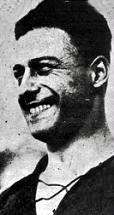Fenerbahçe S.K. (football)
 | ||||
| Full name | Fenerbahçe Spor Kulübü | |||
|---|---|---|---|---|
| Nickname(s) |
Sarı Kanaryalar (The Yellow Canaries) Sarı Lacivertliler (The Navy Blue-Yellows) Efsane (The Legend) Fener | |||
| Founded |
3 May 1907; 109 years ago as Fenerbahçe Futbol Kulübü[lower-alpha 1] | |||
| Ground | Şükrü Saracoğlu Stadium | |||
| Capacity | 50,509[1] | |||
| Coordinates | 40°59′16″N 29°02′12″E / 40.98778°N 29.03667°ECoordinates: 40°59′16″N 29°02′12″E / 40.98778°N 29.03667°E | |||
| Chairman | Aziz Yıldırım | |||
| Manager | Dick Advocaat | |||
| League | Süper Lig | |||
| 2015–16 | Süper Lig, 2nd | |||
| Website | Club home page | |||
|
| ||||
| Active departments of Fenerbahçe | ||
|---|---|---|
| Football | Basketball (Men's) | Basketball (Women's) |
| Volleyball (Men's) | Volleyball (Women's) | Table Tennis |
| Swimming | Rowing | Sailing |
| Athletics | Boxing | |
Fenerbahçe Spor Kulübü (Turkish pronunciation: [feˈnɛrbaht͡ʃe], Fenerbahçe Sports Club), also known as Fenerbahçe or just Fener, was founded as a football club in 1907 in Istanbul, Ottoman Empire. The club's name comes from Fenerbahçe of Istanbul. Fenerbahçe is a major multi-sports club and competes in football, basketball, volleyball, athletics, swimming, sailing, rowing, boxing and table tennis with many major honours won in each. Fenerbahçe is one of the most successful and best supported football teams in Turkey,[2][3] having never been relegated to lower divisions, and currently competes in the Süper Lig and the Turkish Cup. It is nicknamed Sarı Kanaryalar (Turkish for "Yellow Canaries") and plays its home games at Şükrü Saracoğlu Stadium in Kadıköy, Istanbul.
Fenerbahçe has won 34 domestic trophies, including 19 Süper Lig titles, 6 Turkish Cups and 9 Turkish Super Cups. In international club football, Fenerbahçe has won one Balkans Cup trophy, which is marked as the first ever non-domestic trophy won by a Turkish club. In UEFA competitions, Fenerbahçe has reached the quarter-final in the 1963–64 season of the UEFA Cup Winners' Cup and in the 2007–08 season of the UEFA Champions League, their semi-final performance in the 2012–13 season of the UEFA Europa League is marked as their greatest achievement in European competitions.
History
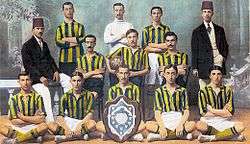

Early years 1907–1959
Fenerbahçe was founded in 1907 in Kadıköy, Istanbul, by local men Ziya Songülen, Ayetullah Bey and Necip Okaner. This group of individuals founded the club secretly in order to keep a low profile and not get into any trouble with the strict Ottoman rule, so strict that the Sultan Abdul Hamid II forbade the Turkish youth to set up a club or engage in the game of football played by the English families that was watched in envy. Ziya Songülen was elected the first president of the club, Ayetullah Bey became the first general secretary and Necip Okaner was given the post of general captain.[4] The lighthouse situated on the Fenerbahçe cape was a big influence on the design of the club's first crest, which sported the yellow and white colors of daffodils around the lighthouse. The kits were also designed with yellow and white stripes.[4] The crest and the colors of the club were changed in 1910 when Hikmet Topuzer redesigned the badge and Ziya Songülen changed the colors to yellow and navy, still seen today. Fenerbahçe's activities were kept in secrecy until a legislation reform in 1908, when, under a new law, all football clubs had to register to exist legally.[4] Fenerbahçe joined the Istanbul Football League in 1909, finishing fifth in their first year. The founding line-up included Ziya Songülen, Ayetullah Bey, Necip Okaner, Galip Kulaksızoğlu, Hassan Sami Kocamemi, Asaf Beşpınar, Enver Yetiker, Şevkati Hulusi Bey, Fuat Hüsnü Kayacan, Hamit Hüsnü Kayacan and Nasuhi Baydar.[5] Fenerbahçe won the 1911–12 season of the Istanbul Football League marking this championship as the first success in its long history. Mustafa Elkatipzade introduced other sports to the club realizing that football should not be the only sport being practised; it is due to his efforts that Fenerbahçe Sports Club was born.[6]
Fenerbahçe played against the staff of the Royal Navy that occupied Istanbul during the Turkish War of Independence. Some British soldiers formed football teams that were named after the players' speciality, for example Essex Engineers, Irish Guards, Grenadiers and Artillery. These teams played against each other and against local football teams in Istanbul. Fenerbahçe won many of these matches.[7]
Winning the first National League
.jpg)
The Turkish Football Federation founded a professional national league in 1959, which continues today under the name of the Süper Lig. Fenerbahçe won the first tournament, beating Galatasaray 4–1 on aggregate.[8] The next year, Fenerbahçe participated in the European Cup for the first time. They qualified through a 4–3 win over Csepel SC being the first Turkish club to advance to the next round by eliminating its opponent. They lost their first-round game to OGC Nice 1–5 in a playoff game after drawing on aggregate.[9] Fenerbahçe reached the quarter-final of the 1963–64 European Cup Winners' Cup where they got knocked out by MTK Budapest. Fenerbahçe won four more league titles in the 1960s and they were also the runners-up three times making them the most successful club of that era.[10][11] Fenerbahçe was coached by Ignáce Molnár at the time, a famous Hungarian coach who had introduced a new style of football in Turkey. Under his guidance Fenerbahçe managed to knock out English champions Manchester City in the first round of the 1968–69 European Cup.
Balkans Cup victory
In the Balkans Cup 1966–67 (a competition set up for Eastern European clubs from Albania, Bulgaria, Greece, Romania, Turkey, and Yugoslavia that existed between the 1960–61 and 1993–94 seasons), Fenerbahçe won the cup after three final matches against Greek club AEK Athens, making them the first Turkish club to win a non-domestic competition. This success would remain unparalleled by a Turkish club until Sarıyer and Samsunspor won the cup many years later in the 1990s.[12]
Later years
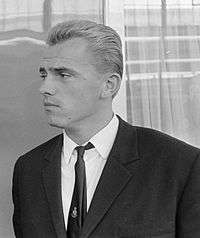
The 1970s saw Fenerbahçe bring in the famous Didi as the new coach. Fenerbahçe won four more league titles including a double with Cemil Turan being the top goal scorer three times. The 1970s also established a rivalry with Trabzonspor, for almost a decade Fenerbahçe and Trabzonspor were competing each other for the title. The 1980s saw Fenerbahçe win three more league titles. Under the guidance of Kálmán Mészöly, Fenerbahçe managed to knock out French champions Bordeaux in the first round of the 1985–86 European Cup. This victory marked a turning point as for almost a decade no Turkish club managed to get past the first round in European competitions.
Galatasaray and Beşiktaş dominated the Turkish League during the 1990s, combining to win nine out of 10 titles, Fenerbahçe's only Turkish League success during the 1990s came in the 1995–1996 season under Carlos Alberto Parreira.[10][11] In the UEFA Champions League 1996–97 season Fenerbahçe completed the group stage with seven points[13] and, amongst others, beat Manchester United 1–0 at Old Trafford undoing the record of the English giants being unbeaten for 40 years in their homeground.
Fenerbahçe won the league title in 2001, denying Galatasaray a fifth consecutive title. They followed up the next season with a runners-up place behind Galatasaray with new coach Werner Lorant. The next season, however, did not go so well as Fenerbahçe finished in sixth place with Ariel Ortega in the squad.[14] Despite this, that season is memorable to many Fenerbahçe fans due to a 6–0 win against arch-rivals Galatasaray in the Şükrü Saracoğlu Stadium on 6 November 2002.[15] After firing Werner Lorant, they hired another German coach, Christoph Daum. Daum had previously coached in Turkey, winning the league with Beşiktaş in 1994–95. Fenerbahçe brought in players including Pierre van Hooijdonk, Mehmet Aurélio and Fabio Luciano as a rebuilding process. These new players lead Fenerbahçe to their fifteenth title and third star (one being awarded for every five league titles won by a club).[16]
The next year was followed up by a narrow championship over Trabzonspor, winning the then record of sixteen Turkish First Football League championships.[17] Fenerbahçe lost the title in the last week of the 2005–06 season to Galatasaray. Fenerbahçe needed a win, but instead drew 1–1 with Denizlispor while Galatasaray won 3–0 over Kayserispor. Soon after, Christoph Daum stepped down as manager,[18] and was replaced by Zico on 4 July 2006.[19][20] Zico began his reign by signing two new defenders, highly touted Uruguayan international Diego Lugano and fellow Brazilian Edu Dracena.[21] Zico also signed two strikers, Serbian international Mateja Kežman, and another Brazilian, Deivid de Souza.[22] Fenerbahçe's 2006–07 domestic season started off with a 6–0 win over relegation candidates Kayseri Erciyesspor.[23] In the 32nd week of the Süper Lig, Fenerbahçe drew Trabzonspor 2–2, while Beşiktaş lost to Bursaspor 0–3, putting the former out of contention for the title.[24][25] Fenerbahçe won their seventeenth Süper Lig title in the 2006–07 season.[26]
2007–2016

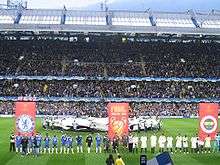

.jpg)
On 11 January 2007, Fenerbahçe was officially invited to G-14.[27] G-14 is an association which consists of top European clubs. Fenerbahçe is the only Turkish club that have been invited to this association. In March 2008, Fenerbahçe's record application's accepted by Guinness World Records Menagement Team, which envisages Fenerbahçe to have the most medal and trophy achievements on the planet with its 9 branches entirely, a total of 1134 cups and medals.[28] Under Zico’s command, Fenerbahçe qualified from the UEFA Champions League 2007–08 group stage for the first time in the club's history and went on to beat Sevilla to become a quarter-finalist in the 2007–08 season. Zico is also the most successful manager of the team's history in the UEFA Champions League. After successful scores both in local league of Turkey and international matches, Zico gained a new nickname from the Fenerbahçe fans: Kral Arthur (meaning "King Arthur" in Turkish). In February 2009, Fenerbahçe became the first Turkish club to enter the Deloitte Football Money League.[29] Since 2000, Fenerbahçe improved the club's finances and facilities, bringing world stars to the club such as Haim Revivo, Ariel Ortega, Serhiy Rebrov, Pierre van Hooijdonk, Alexsandro de Souza, Stephen Appiah, Nicolas Anelka and lately Mateja Kežman, Roberto Carlos, and Dani Güiza.
Fenerbahçe's 2009–10 season ended as they lost the title on the last matchday. The Fenerbahçe players were told that a draw would be enough towards the end of the match only to find out that the other critical game went against their favour as Bursaspor beat Beşiktaş 2–1 to win the title. Despite the title loss, Fenerbahçe ended the season with the most clean sheets (10), as well as the joint longest winning streak (8).[30] In July 2011, Fenerbahçe fans invaded the pitch during a friendly against the Ukrainian champions Shakhtar Donetsk. As punishment, Fenerbahçe was sentenced to two Turkish League games in an empty stadium. The TFF later allowed those two games to be filled with spectators; the men were barred while women and children under twelve were admitted for free.[31] On 29 October 2012, Antalyaspor ended Fenerbahçe’s 47-match unbeaten run in the Süper Lig at the Şükrü Saracoğlu Stadium. Fenerbahçe had not lost a single match at home ever since they were beaten 2–3 by eventual champions Bursaspor in week 22, on 22 February 2010. Fenerbahçe won 38 and drew nine in the 47 matches they played within 980 days since 22 February 2010.[32] On 3 November 2012, Fenerbahçe peck Akhisar Belediyespor to break 181-day away jinx.[33] On 2 May 2013, Fenerbahçe was eliminated by Benfica 3–2 on aggregate in the semi-final of the 2012–13 Europa League, this is the biggest success in Fenerbahçe's history in UEFA competitions.[34][35][36]
On 28 June 2013, Ersun Yanal has agreed to take charge of Fenerbahçe, replacing Aykut Kocaman who resigned at the end of May.[37][38] Ersun Yanal's appointment coincides with tough times for Fenerbahçe who have been banned from European competitions for two seasons over their involvement in a domestic match-fixing scandal. Fenerbahçe, who finished second in the Süper Lig last season, will miss out on next season's Champions League which they had been due to enter in the third qualifying round.[39][40][41] Fenerbahçe finished the 2014–15 season as runners-up forcing the board of directors to undertake some major changes. For the 2015–16 season Fenerbahçe brought in Vítor Pereira as the new coach. Portuguese star Nani, Danish defender Simon Kjær and the flying Dutchman Robin van Persie were added to the squad to fulfill the clubs ambitions to be successful in the Turkish League and European competitions. On 10 December 2015, Fenerbahçe played its 200th European game against Celtic.
Former players
When it was first founded in 1907, Fenerbahçe had a large squad. One of these players, Galip Kulaksızoğlu, was the longest serving player of the original squad. He spent seventeen years at the club, retiring in 1924 after 216 matches.[42] Zeki Rıza Sporel was the first product of the Fenerbahçe youth system. During his eighteen-year career with the club, Zeki Rıza scored 470 goals in 352 matches, or 1.3 goals every match.[42] Zeki Rıza was also capped for the Turkey national football team sixteen times, scoring 15 goals. Cihat Arman became the first in a long-line of long-serving goalkeepers. Cihat played twelve seasons at the club, playing in 308 matches.[42]
Lefter Küçükandonyadis was one of the first Turkish football players to play in Europe. Lefter spent two seasons in Europe, playing for ACF Fiorentina and OGC Nice before returning to Fenerbahçe. In all, Lefter scored 423 goals in 615 matches for the club, helping them to two Istanbul Football League titles and three Turkish League titles. Another player, Can Bartu, became the next big Turkish export to Europe. He was also the first Turkish football player to play in a European competition final, doing so with Fiorentina against Atlético Madrid in 1962. Can also spent some seasons playing for Venezia and Lazio before returning to Fenerbahçe in 1967. He was a four-time league champion with Fenerbahçe and scored 162 goals in 330 matches. Some of the other top Turkish players who played for Fenerbahçe are; Fikret Arıcan, Fikret Kırcan, Burhan Sargun, Nedim Doğan, Cemil Turan, Selçuk Yula, Rıdvan Dilmen and Rüştü Reçber.
Former Romanian goalkeeper Ilie Datcu was the first foreigner to reach 100 caps for Fenerbahçe. In recent decades, Fenerbahçe have gained an influx of foreigners who have helped the club to a joint-record of seventeen league titles. Among these have been Uche Okechukwu, who after 13 seasons with Fenerbahçe and Istanbulspor became the longest serving foreigner in Turkey. During Uche's career with Fenerbahçe, he won two league titles and became a fan favourite. In more recent times, Fenerbahçe has been the home to Brazilian-born Mehmet Aurélio who, in 2006, became the first naturalized Turkish citizen to play for the Turkey national football team. Wederson another Brazilian-born naturalized Turkish citizen, was added to the squad at the beginning of the 2007–08 season and subsequently played for Bursaspor, after his release by Fenerbahçe on 31 May 2010. Alexsandro de Souza is another Brazilian player who scored the most goals of all foreign players who have played for Fenerbahçe. Some of the other top players who played for Fenerbahçe are; Jay-Jay Okocha (1996–98), Kenneth Andersson (2000–02), Ariel Ortega (2002–03), Pierre Van Hooijdonk (2003–05), Nicolas Anelka (2005–06), Mateja Kežman (2006–09) and Roberto Carlos (2007–09)
Supporters
Fenerbahce fans are known as "Number 12" as to their continuous support as if they are in the field playing as the "12th player" on the team. Jersey number 12 is dedicated to the fans and no player on the team wears it. Many fanzines, blogs, podcasts, forums and fans websites have been dedicated to the team and the fans have long-standing rivalries with several other clubs; the most notable of these is with neighbours Galatasaray with whom they regularly contest the Intercontinental derby and Beşiktaş with whom they regularly contest the Istanbul derby. Since rebuilding the Şükrü Saracoğlu Stadium, Fenerbahçe's average attendances have been in the top in Turkey.[43] Fenerbahçe have a number of supporters organisations, including Genç Fenerbahçeliler (GFB), Kill For You (KFY), UniFeb (Fenerbahçe Supporters of University Students), Grup CK (Cefakâr Kanaryalar), Vamos Bien (A Leftist Group), Ultras Fener and EuroFeb (Fenerbahçe Supporters of who live in Europe). The supporters motto is Hep Destek Tam Destek, abbreviated as HDTD (English: Continuous Unwavering Support, Spanish: Te Apoyo Siempre, Te Apoyo Entodo).
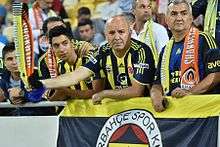
In addition to the usual Turkish football chants, Fenerbahçe's supporters mostly sing "Fenerbahçe Anthem", sung to the tune of Eviva España, "1907 Anthem", "100th Year Anthem", "Being a Fenerbahçe Fan" and "My Blood is Yellow and Navy" anthems in Şükrü Saraçoğlu Stadium before matches. More recently, in November 2011, Fenerbahçe's Genç Fenerbahçeliler created a friendly relationship with Torcida Sandžak, the organized supporters of the Serbian club FK Novi Pazar. During a Turkish Süper Lig match against İstanbul Büyükşehir Belediyespor at the Şükrü Saraçoğlu Stadium, the Genç Fenerbahçeliler and 1907 Gençlik stand deployed a giant banner reading "Kalbimiz Seninle Novi Pazar" (Novi Pazar, Our Heart With You)[44] and after then in Radnicki Kragujevac match of Serbian SuperLiga, Torcida Sandžak stand deployed a giant banner reading "Sancak'ta atıyor, Fenerbahçe'nin kalbi" (Heartbeating of Fenerbahçe in Sandžak).[45] On 2 March 2012, Fenerbahçe's Genç Fenerbahçeliler and 1907 Gençlik supporters groups members invited to Novi Pazar for Partizan match in Serbian SuperLiga. Thousands Torcida Sandžak member welcomed Genç Fenerbahçeliler and 1907 Gençlik's 17 members.[46]
Stadium

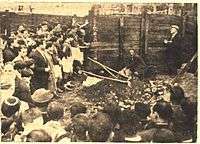
Fenerbahçe play their home games at the Şükrü Saracoğlu Stadium,[47] in the Kadıköy district of Istanbul, since 1908. Most recently renovated between 1999 and 2006, its capacity is 50,509.[1] Unusually for a Turkish football stadium there is no running track around the outside of the pitch. The club's museum has been situated in the stadium since 2005, after having been at a variety of locations.[48] Before Şükrü Saracoğlu Stadium was built, the field was known as Papazın Çayırı (The field of the priest). The field, however, became the very first football pitch of Turkey, where the first league games of the Istanbul Football League were all held successively. In 1908, local teams of the league needed a regular soccer field, so this land was leased from the Ottoman Sultan Abdülhamid II for 30 Ottoman gold pounds a year. The total construction cost was 3,000 Ottoman gold pounds. The name was changed to the Union Club Field after the club which made the highest donation for the construction.
The Union Club Field was used by many teams in İstanbul, including the owner, Union Club (which changed its name to İttihatspor after World War I), Fenerbahçe, Galatasaray and Beşiktaş. However, it had lost its importance when a bigger venue, the Taksim Stadium, was built in 1922, inside the courtyard of the historic Taksim Topçu Kışlası (Taksim Artillery Barracks), which was located at the present-day Taksim Gezi Parkı (Taksim Park). İttihatspor (which had close relations with the political İttihat ve Terakki), was forced to sell it to the state, in which Şükrü Saracoğlu was a member of the CHP government. Thus, the ownership of the stadium passed to the state, but the field was immediately leased to Fenerbahçe. Later, on 27 May 1933, Fenerbahçe purchased the stadium from the government when Şükrü Saracoğlu was the president of Fenerbahçe, for either the symbolic amount of 1 TL or the worth of the stadium which was 9000 TL.

The name of the field was changed to Fenerbahçe Stadium, and this made Fenerbahçe the first football club in Turkey to own its stadium, with the help of the government. In the following years, Fenerbahçe renovated the stadium and increased its seating capacity. By 1949, Fenerbahçe Stadium was the largest football venue in Turkey, with a seating capacity of 25,000. The name of the stadium was changed once more in 1998, becoming Fenerbahçe Şükrü Saracoğlu Stadium, named after Fenerbahçe's president and Turkey's 6th prime minister, Şükrü Saracoğlu. In 1999, the latest round of renovations and capacity increasing projects started. The tribunes on the four sides of the stadium were torn down one at a time, as the Turkish Super League seasons progressed, and the entire renewal and construction project was finalised in 2006, with the efforts of the Fenerbahçe president Aziz Yıldırım and the team's board of directors.
Şükrü Saracoğlu
Mehmet Şükrü Saracoğlu was a politician and was to be the fifth Prime Minister of Turkey. He was born in 1887 at Odemis. Saracoğlu progressed as being a teacher before graduating from foreign faculties. Saracoğlu also became the Minister of Education in 1924. Saracoğlu was successful at every area even in politics and was a statesman in Turkey. He was also a keen Fenerbahçe supporter and was the president of the club from 1934 to 1950, which made him the longest serving Fenerbahçe president. In 1953, three years after retiring from politics, he died in Istanbul on 27 December.[49]
Club crest and colours
Since the club's foundation, Fenerbahçe has used the same badge, which has only undergone minor alterations.
It was designed by Hikmet Topuzer, nicknamed Topuz Hikmet, who played as left winger, in 1910, and had made as lapel pins by Tevfik Haccar Taşçı in London. The crest consists of five colours. The white section which includes the writing Fenerbahçe Spor Kulübü ★ 1907 ★ represents purity and open-heartedness, the red section represents love and attachment to the club and symbolises the Turkish flag. The yellow section symbolises other ones' envy and jealousy about Fenerbahçe, while the navy symbolises nobility. The oak leaf which rises from the navy and yellow section shows the force and the power of being a member of Fenerbahçe. The green colour of the leaf shows the success of Fenerbahçe is imperative.[50] Hikmet Topuzer describes the story of the emblem as below:
| “ | After the change of the club’s colours from yellow and white to yellow and navy, it was an issue to create an emblem with our new colours. My friends left the design of this emblem to me. Firstly, I brought together the colours of our national flag, red and white. Then drew a heart shape over the red and gave it a yellow and navy colour, adding an acorn leaf that represents resistance, power and strength. I wrote the club name and foundation date on the white section. When drawing our emblem, I tried to give this meaning: Serving the club with dependence from heart. The design was favored by my friends and our new emblem was made through the guidance of Tevfik Haccar, who was in Germany at time. After the new alphabet was approved, the design was protected, but the club name on the emblem was changed to Fenerbahçe Spor Kulübü ★ 1907 ★.[50] | ” |
Rivalries with other Istanbul clubs
"The big three" clubs of Istanbul (Beşiktaş, Galatasaray and Fenerbahçe) have a century-long history of rivalry. The Fenerbahçe-Galatasaray rivalry is the primary Istanbul derby and the most important rivalry in Turkish football; matches between the two teams are known as Kıtalar Arası Derbi ("Intercontinental Derby"). The rivalry started on 23 February 1934, when a friendly game between both clubs turned into a riot, and the match had to be abandoned.
The rivalry has led to violence among supporters on numerous occasions.[51] Torches, smoke, flags, and giant posters are used to create visual grandeur and apply psychological pressure on visiting teams, which fans call "welcoming them to hell".
Players
Current squad
Note: Flags indicate national team as defined under FIFA eligibility rules. Players may hold more than one non-FIFA nationality.
|
|
Out on loan
Note: Flags indicate national team as defined under FIFA eligibility rules. Players may hold more than one non-FIFA nationality.
|
Fenerbahçe A2
- Main article: Fenerbahçe S.K. A2[52]
Academy teams
Retired number(s)
Team captains
Player records
- Most appearances in all time: 763 –
 Müjdat Yetkiner
Müjdat Yetkiner - Most goals in all time: 470 –
 Zeki Rıza Sporel
Zeki Rıza Sporel - Most goals in Süper Lig: 140 –
 Aykut Kocaman
Aykut Kocaman - Most goals in one match: 8 –
 Zeki Rıza Sporel (vs Anadolu, 1931) and
Zeki Rıza Sporel (vs Anadolu, 1931) and  Melih Kotanca (vs Topkapı, 1940)
Melih Kotanca (vs Topkapı, 1940) - Most goals in one league match: 6 –
 Tanju Çolak (vs Karşıyaka, 1992–93)
Tanju Çolak (vs Karşıyaka, 1992–93) - Most goals in UEFA competitions: 15 –
 Alexsandro de Souza
Alexsandro de Souza - Most appearances in UEFA competitions: 65 –
 Volkan Demirel
Volkan Demirel
European record
Fenerbahçe have had some impressive wins against the greatest clubs in European football, having beaten Manchester United, Parma, Sevilla, Internazionale, Rangers, Anderlecht, PSV Eindhoven, Marseille, Ajax, Borussia Mönchengladbach, Manchester City, Bordeaux, Lazio, Benfica, CSKA Moscow, Chelsea and IFK Göteborg, among many others.
European Cup / UEFA Champions League
| European Cup / UEFA Champions League | |||||
|---|---|---|---|---|---|
| Season | Round | Rival | Home | Away | Agg. |
| 1959–60 | Preliminary round | 1–1 | 2–3 | 4–3 | |
| Round of 16 | 2–1 | 2–1 | 3–3 (a) | ||
| 1961–62 | First round | 1–2 | 1–0 | 1–3 | |
| 1964–65 | Preliminary round | 0–1 | 3–1 | 1–4 | |
| 1965–66 | Preliminary round | 0–0 | 5–1 | 1–5 | |
| 1968–69 | First round | 2–1 | 0–0 | 2–1 | |
| Second round | 0–2 | 2–0 | 0–4 | ||
| 1970–71 | First round | 0–4 | 1–0 | 0–5 | |
| 1974–75 | First round | 2–0 | 2–3 | 5–2 | |
| Second round | 0–2 | 2–1 | 1–4 | ||
| 1975–76 | First round | 1–0 | 7–0 | 1–7 | |
| 1978–79 | First round | 2–1 | 6–1 | 3–7 | |
| 1983–84 | First round | 0–1 | 4–0 | 0–5 | |
| 1985–86 | First round | 0–0 | 2–3 | 3–2 | |
| Second round | 2–1 | 4–0 | 2–5 | ||
| 1989–90 | First round | 1–2 | 3–1 | 2–5 | |
| 1996–97 | Qualifying round | 1–1 | 0–1 | 2–1 | |
| Group Stage (Group C) |
1–0 | 1–1 | – | ||
| 0–1 | 2–0 | ||||
| 0–2 | 0–1 | ||||
| 2001–02 | Third qualifying round | 2–1 | 0–0 | 2–1 | |
| Group Stage (Group F) |
0–3 | 1–0 | – | ||
| 0–1 | 3–1 | ||||
| 1–2 | 2–1 | ||||
| 2002–03 | Third qualifying round | 0–2 | 1–0 | 0–3 | |
| 2004–05 | Group Stage (Group D) |
1–0 | 0–1 | – | |
| 3–0 | 6–2 | ||||
| 1–4 | 4–2 | ||||
| 2005–06 | Group Stage (Group E) |
0–4 | 3–1 | – | |
| 3–0 | 2–0 | ||||
| 3–3 | 2–0 | ||||
| 2006–07 | Second qualifying round | 4–0 | 0–5 | 9–0 | |
| Third qualifying round | 2–2 | 3–1 | 3–5 | ||
| 2007–08 | Third qualifying round | 1–0 | 0–2 | 3–0 | |
| Group Stage (Group G) |
1–0 | 3–0 | – | ||
| 3–1 | 2–2 | ||||
| 2–0 | 0–0 | ||||
| Round of 16 | 3–2 | 3–2 (a.e.t.) | 5–5 (3–2 p.) | ||
| Quarter-finals | 2–1 | 2–0 | 2–3 | ||
| 2008–09 | Second qualifying round | 2–0 | 0–5 | 7–0 | |
| Third qualifying round | 2–1 | 2–2 | 4–3 | ||
| Group Stage (Group G) |
1–2 | 3–1 | – | ||
| 0–0 | 1–0 | ||||
| 2–5 | 0–0 | ||||
| 2010–11 | Third qualifying round | 0–1 | 2–2 | 2–3 | |
| 2011–12 | |||||
| 2012–13 | Third qualifying round | 1–1 | 1–4 | 5–2 | |
| Play-off round | 1–1 | 2–1 | 2–3 | ||
| 2013–14 | Third qualifying round | |
3–1 | 1–1 | 4–2 |
| Play-off round | |
0–3 | 2–0 | 0–5 | |
| 2014–15 | |||||
| 2015–16 | Third qualifying round | 0–0 | 3–0 | 0–3 | |
| 2016–17 | Third qualifying round | 2–1 | 3–1 | 3–4 | |
UEFA Cup / UEFA Europa League
| UEFA Cup / UEFA Europa League | |||||
|---|---|---|---|---|---|
| Season | Round | Rival | Home | Away | Agg. |
| 1971–72 | First round | 1–1 | 3–1 | 2–4 | |
| 1972–73 | First round | 1–0 | 3–0 | 1–3 | |
| 1973–74 | First round | 5–1 | 1–1 | 6–2 | |
| Second round | 2–0 | 4–0 | 2–4 | ||
| 1976–77 | First round | 2–1 | 4–0 | 2–5 | |
| 1977–78 | First round | 0–4 | 2–0 | 0–6 | |
| 1980–81 | First round | 0–1 | 2–1 | 1–3 | |
| 1984–85 | First round | 0–1 | 2–0 | 0–3 | |
| 1990–91 | First round | 3–0 | 2–3 | 6–2 | |
| Second round | 0–1 | 4–1 | 5–1 | ||
| 1992–93 | First round | 3–1 | 2–2 | 5–3 | |
| Second round | 1–0 | 7–1 | 7–2 | ||
| 1994–95 | Preliminary round | 5–0 | 0–2 | 7–0 | |
| First round | 1–5 | 4–0 | 1–9 | ||
| 1995–96 | Preliminary round | 2–0 | 0–4 | 6–0 | |
| First round | 1–2 | 2–0 | 1–4 | ||
| 1997–98 | First round | 1–2 | 0–0 | 1–2 | |
| 1998–99 | Second qualifying round | 1–0 | 2–1 | 2–2 (a) | |
| First round | 1–0 | 1–3 | 2–3 | ||
| 1999–00 | First round | 0–2 | 0–0 | 0–2 | |
| 2002–03 | First round | 3–1 | 3–3 | 6–4 | |
| Second round | 1–1 | 4–1 | 2–5 | ||
| 2004–05 | Round of 32 | 0–1 | 2–1 | 3–1 | |
| 2006–07 | First round | 2–1 | 0–3 | 5–1 | |
| Group Stage (Group H) |
– | 1–0 | – | ||
| 3–0 | – | ||||
| – | 1–0 | ||||
| 2–2 | – | ||||
| Round of 32 | 3–3 | 2–2 | 5–5 (a) | ||
| 2009–10 | Third qualifying round | 5–1 | 1–1 | 6–2 | |
| Play-off round | 2–2 | 0–2 | 4–2 | ||
| Group Stage (Group G) |
1–2 | 0–1 | – | ||
| 1–0 | 0–1 | ||||
| 3–1 | 0–1 | ||||
| Round of 32 | 1–1 | 2–1 | 2–3 | ||
| 2010–11 | Play-off round | 1–1 | 1–0 | 1–2 | |
| 2011–12 | |||||
| 2012–13 | Group Stage (Group C) |
2–2 | 0–1 | – | |
| 0–3 | 2–4 | ||||
| 2–0 | 0–1 | ||||
| Round of 32 | 1–0 | 0–0 | 1–0 | ||
| Round of 16 | 1–1 | 0–1 | 2–1 | ||
| Quarter-finals | 2–0 | 1–1 | 3–1 | ||
| Semi-finals | 1–0 | 3–1 | 2–3 | ||
| 2013–14 | |||||
| 2014–15 | |||||
| 2015–16 | Play-off round | 3–0 | 0–1 | 4–0 | |
| Group Stage (Group A) |
1–0 | 0–0 | – | ||
| 1–1 | 2–2 | ||||
| 1–3 | 0–2 | ||||
| Round of 32 | 2–0 | 1–1 | 3–1 | ||
| Round of 16 | |
1–0 | 4–1 | 2–4 | |
| 2016–17 | Play-off round | |
3–0 | 0–2 | 5–0 |
| Group Stage (Group A) |
|
2–1 | 4–1 | – | |
| |
1–0 | – | |||
| |
2–0 | 1–1 | |||
European history
| Season | Achievement | Notes | |
|---|---|---|---|
| UEFA Champions League | |||
| 2007–08 | Quarter-Finalist | eliminated by | |
| UEFA Europa League | |||
| 2012–13 | Semi-Finalist | eliminated by | |
Competition
- As of 26 August 2016
| Competition | Pld | W | D | L |
|---|---|---|---|---|
| UEFA Champions League | 103 | 32 | 19 | 52 |
| UEFA Europa League | 98 | 42 | 22 | 34 |
League and domestic cup history
| Season | Pos. | Pl. | W | D | L | GS | GA | P | Domestic Cup |
|---|---|---|---|---|---|---|---|---|---|
| 2003–04 | 1 | 34 | 23 | 7 | 4 | 82 | 41 | 76 | Semi-Finals |
| 2004–05 | 1 | 34 | 26 | 2 | 6 | 77 | 24 | 80 | Runners-Up |
| 2005–06 | 2 | 34 | 25 | 6 | 3 | 90 | 34 | 81 | Runners-Up |
| 2006–07 | 1 | 34 | 20 | 10 | 4 | 65 | 21 | 70 | Semi-Finals |
| 2007–08 | 2 | 34 | 22 | 7 | 5 | 72 | 37 | 73 | Quarter-Finals |
| 2008–09 | 4 | 34 | 18 | 7 | 9 | 60 | 36 | 61 | Runners-Up |
| 2009–10 | 2 | 34 | 23 | 5 | 6 | 61 | 28 | 74 | Runners-Up |
| 2010–11 | 1 | 34 | 26 | 4 | 4 | 84 | 34 | 82 | Group stage |
| 2011–12 | 2 | 34 | 20 | 8 | 6 | 61 | 34 | 68 | Winners |
| 2012–13 | 2 | 34 | 18 | 7 | 9 | 56 | 39 | 61 | Winners |
| 2013–14 | 1 | 34 | 23 | 5 | 6 | 74 | 33 | 74 | Fourth Round |
| 2014–15 | 2 | 34 | 22 | 8 | 4 | 60 | 29 | 74 | Semi-Finals |
| 2015–16 | 2 | 34 | 22 | 8 | 4 | 60 | 27 | 74 | Runners-Up |
Honours
Competitions
International
- UEFA Cup Winners' Cup
- Quarter Finals (1): 1963-64
- UEFA Champions League:
- Quarter-finals (1): 2007–08
- UEFA Cup / UEFA Europa League:
- Semi-finals (1): 2012–13
Domestic
National Championships – 28 (record)
- Süper Lig
- Champions (19): 1959, 1960–61, 1963–64, 1964–65, 1967–68, 1969–70, 1973–74, 1974–75, 1977–78, 1982–83, 1984–85, 1988–89, 1995–96, 2000–01, 2003–04, 2004–05, 2006–07, 2010–11, 2013–14
- Runners-up (21): 1959–60; 1961–62; 1966–67; 1970–71; 1972–73; 1975–76; 1976–77; 1979–80; 1983–84; 1989–90; 1991–92; 1993–94; 1997–98; 2001–02; 2005–06; 2007–08; 2009–10; 2011–12; 2012–13; 2014–15; 2015–16
- Turkish Football Championship (3)
- Turkish National Division Championship (6) (record)
National Cup – 6
National Super Cup – 9
Others
European
- Balkans Cup (1)
Domestic
- Chancellor Cup (8) (record)
- Atatürk Cup (2) (record)
- TSYD Cup (12) (shared-record)
- Spor Toto Cup (1)
- Istanbul Football League (15) (shared-record)
- Istanbul Shield (4) (record)
Fenerbahçe as a company
Fenerbahçe Futbol A.Ş. is a listed company in Borsa Istanbul as BİST: FENER, Fenerbahçe Spor Kulübü owned 67.07% stake. The company had a negative equity of 424,317,388 Turkish lire; total assets of 311,233,179 lire; revenue 317,610,262 lire and a net loss of 181,234,264 in 2014–15 season.[55] Fenerbahçe S.K. entered a settlement agreement with UEFA for breaching UEFA Financial Fair Play Regulations (FFP) on 20 May 2016.[56] The club was required to have an aggregate break-even in 2019 (2016–17, 2017–18 and 2018–19 season), and more specifically a maximum annual net loss of €30 million, €20 million and €10 million in 2015–16, 2016–17 and 2017–18 season.
Turkish clubs Beşiktaş, Kardemir Karabükspor and Trabzonspor (twice) also entered into settlement agreements in 2014, 2015 and 2016, with Bursaspor and Galatasaray were banned from European football in 2015 and 2016 respectively due to breaching overdue payable and the settlement agreement respectively.
Trivia

- Fenerbahçe went through the 1922–23 season of the Istanbul Football League undefeated without conceding a single goal.
- First Turkish club to win a non-domestic trophy (Balkans Cup in 1967)[57]
- All-time best in Turkish League cumulative standings with the highest number of wins and the least losses as well as the most scoring football team in history.[58]
- Best winning percentage in a season:
- 29 wins and 6 draws in 36 matches, 0.888 in the 1988–89 season
- Best group stage finish for a Turkish club in the Champions League:
- 11 points in 6 games against
 Inter,
Inter,  CSKA Moscow and
CSKA Moscow and  PSV Eindhoven, 2007–08
PSV Eindhoven, 2007–08
- 11 points in 6 games against
- Best group stage finish for a Turkish club in the Europa League:
- 15 points in 6 games against
 Twente,
Twente, 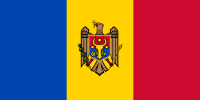 Sheriff Tiraspol and
Sheriff Tiraspol and  Steaua Bucureşti, 2009–10
Steaua Bucureşti, 2009–10
- 15 points in 6 games against
Club league highs and lows
|
|
Staff
| Manager | |
| Administrative Manager | |
| Assistant Coach | |
| Assistant Coach | |
| Goalkeeper Coach | |
| Doctor | |
| Physiotherapist | |
| Physiotherapist | |
| Physiotherapist |
Source: Fenerbahce.org
BoardMain article: List of Fenerbahçe S.K. presidents
|
